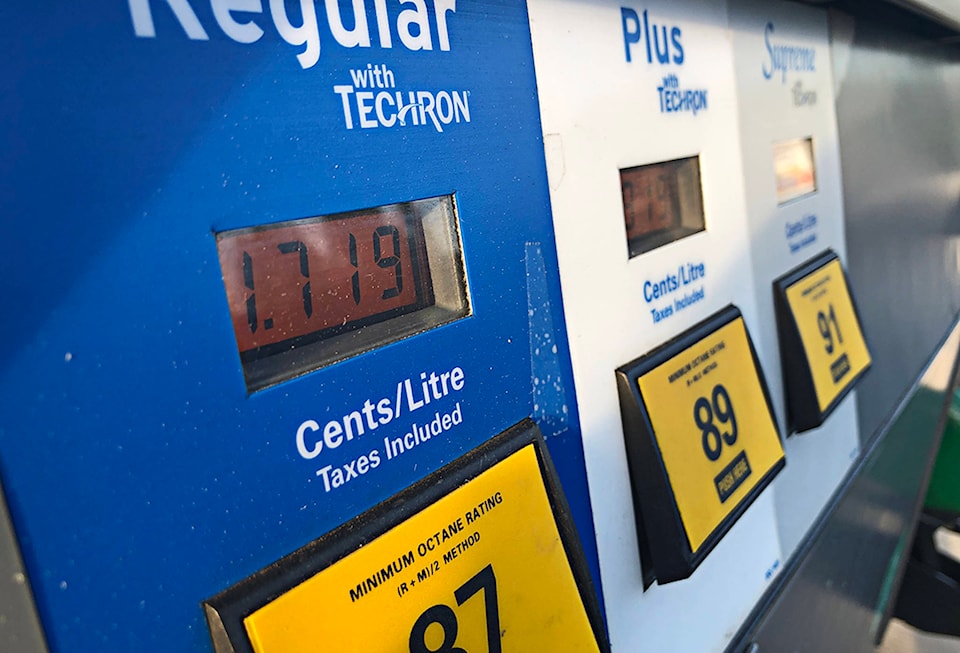Metro Vancouver drivers are being told to prepare for $1.70 per litre of gas to be the “new normal,” but how much do commuters really know about what goes into the price at the pump?
Black Press Media spoke with science blogger Blair King of Langley, and reviewed statistics from GasBuddy.com to compile a “Gas Prices 101” look at how the prices are broken down and who decides them.
A number of taxes make up a standard chunk of the per-litre price, King said in a phone interview this week, amid prices reaching as high as 172.9 cents a litre in various areas earlier this week.
This includes roughly 15 cents in provincially-set taxes, a 10-cent federal excise tax, GST, and a 17-cent TransLink tax only in Metro Vancouver.
READ MORE: Horgan heckled as gas prices sit at record high, could go up more
That adds up to roughly 50 to 60 cents, and doesn’t change as gas prices increase of decrease.
“Then you have the rack price,” King said. That price is what retailers pay for the gas, as set by oil companies.
Rack prices, which are posted online each day at 6 p.m., are determined in part by the cost of the crude oil itself, any overhead, transporting the refined oil and the refineries’ profit.
Distributors must also pay a scarcity premium, King said, which is higher in B.C. because of the high costs to transport gas to West Coast refineries.
“Because of the nature of our gas market in B.C., a lot of our gas comes from the same location – the Parkland facility in Burnaby,” King said, as well as a refinery in Washington State.
“Everyone has to buy from a small number of suppliers. Because it’s a competitive marketplace, they can’t be off by too much.”
Rack prices as of late have been highest for Nanaimo and the surrounding region, or about 107 cents a litre, followed by the Lower Mainland and Kamloops.
“Each of the major companies post their rack prices online, to ensure that no one’s scamming each other,” King said. “Rack prices are provided across the country, and you can see exactly what Suncor or Esso is charging.”
Consumers face one final hit as the fuel makes its ways to gas stations: the dealer’s markup.
Gas stations usually aim to make 10 to 12 cents off each litre, he said, and competition between them is fierce.
“It’s really hard to gouge people because the prices are all public,” King said. “When you’re driving down the street, you see the nearest gas price, but you can also see the gas prices from the guy on the next corner.”
He added that the amount that gas stations take has been declining over the last decade. Owners have tried to make up the revenue by selling chips, drinks and other items or partnering with grocery stores.
“If you have a facility like Costco, where they pump out tens of thousands of litres a day, have two guys working there and really no overhead, then they don’t need as big of a retailer margin,” King said.
“It’s a cutthroat business in that everyone’s working in really tight margins, but everyone is trying to sell as much product as they can, because they make money only when they sell a lot.”
So what can consumers do?
King suggested the best thing consumers can do is look for the rare occasion a station is forced to drop prices because of issues with supply or changeover of product, and plan to fill up in the evening instead of in the morning.
“The gas prices go up in the morning because commuters are driving to work and realizing they won’t have enough gas to get to work and back again, while in the afternoon people are coming home and think they have time.”
The fact gas station owners or price gouging aren’t to blame for may not be what consumers want to hear, but King said prices will only remain high as long as supply is problem on the West Coast.
“Because building a new refinery is really expensive,” King added, “[companies] have fine tuned the market here so the only time we have shortages is when something happens to affect supply, be it a refinery shutting down or changing over from winter to summer blend.”
Until the Trans Mountain pipeline expansion gets approved, if ever, “it’s really a seller’s market.”
@ashwadhwani
ashley.wadhwani@bpdigital.ca
Like us on Facebook and follow us on Twitter.
